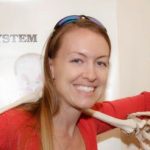Applied Human Anatomy with Lab
The purpose of this course is to introduce students to anatomy (the study of the body’s structures) and to present information and engage students in a way that promotes critical and creative thinking within the context of health and movement studies.
Students will be asked not only to memorize important structures of the human body but also to understrand how the structures and tissues function so that the information can be applied to novel, clinical scenarios. This combination enhances the long‐term retention of the concepts covered and prepare students for future courses they may take which require health or movement‐based problem solving.
| Course: | APK 2100C Applied Human Anatomy w/ Lab |
| Credits: | 4 |
| Instructor: |
Applied Physiology & Kinesiology
College of Health & Human Performance
|
This anatomy course will describe the human body from a systemic approach. This course covers not only gross anatomy of the body’s organs and systems, but also the functionally significant microscopic/histological aspects of these larger structures. The following systems will be covered in this course: integumentary, cardiovascular, musculoskeletal, respiratory, digestive, urinary, and nervous.
The human head is of the same approximate size and weight as a roaster chicken. I have never before had occasion to make the comparison, for never before today have I seen a head in a roasting pan.
There are no prerequisites for this course; however, any previous experiences in the following areas will be helpful to students taking this course: medical terminology, physiology, physics, chemistry, and/or biology. To be clear: you do not need to have taken any of these courses to be successful in this course.
Course Goals:
- Identify and describe the gross and microscopic structures of the organ systems covered.
- Describe the relationship between structure and function at all levels of anatomical organization (molecular, cellular, tissue, organ, system, organism).
- Communicate with peers and professionals using anatomical terminology.
- Predict functions of unknown body structures if given the anatomical make-up or vice-versa (predict anatomical make-up of body structures if given clues about function).
- Predict potential causes of disease/injury symptoms from a functional anatomy perspective.
Meet the instructor & find out more about the course
Current students
Talk to your Academic Advisor to see how this course could fit into your academic plan. We’d love for you to join us in this online learning adventure.Image source: flic.kr/p/hu1KuT

